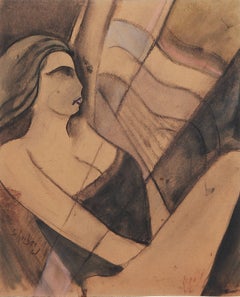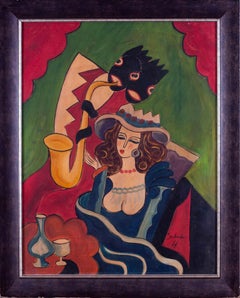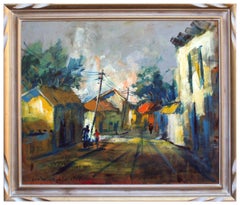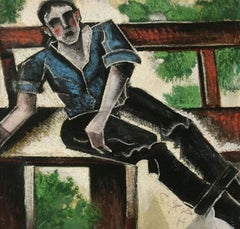Hugó Scheiber Art
to
12
3
15
7
6
4
3
2
"Jazz Musician" Oil Painting 1930 by Hugó Scheiber
By Hugó Scheiber
Located in Berlin, DE
Oil on wood, 1930. Signed lower right. Framed. Height 31.10 in ( 79 cm ), Width 25.19 in ( 64 cm )
The Hungarian artist Hugó Scheiber lived 1922-1934 in Berlin, that's where he pain...
Category
1930s Cubist Hugó Scheiber Art
Materials
Oil, Wood Panel
Hugó Scheiber Pastel "Sailing", about 1930
By Hugó Scheiber
Located in Berlin, DE
Pastel and carbon pencil on cardboard, ca. 1930 by Hugo Scheiber. Signed lower left: Scheiber H.
Dimensions: 14.96 x 12.99 in ( 38 x 33 cm ), Framed: 19.69 x 15.75 in ( 50 x 40 cm )
...
Category
Early 20th Century Expressionist Hugó Scheiber Art
Materials
Pastel, Cardboard, Carbon Pencil
Rare Modernist Hungarian Rabbi Pastel Drawing Gouache Painting Judaica Art Deco
By Hugó Scheiber
Located in Surfside, FL
Rabbi in the synagogue at prayer wearing tallit and tefillin.
Hugó Scheiber (born 29 September 1873 in Budapest – died there 7 March 1950) was a Hungarian modernist painter.
Hugo Scheiber was brought from Budapest to Vienna at the age of eight where his father worked as a sign painter for the Prater Theater. At fifteen, he returned with his family to Budapest and began working during the day to help support them and attending painting classes at the School of Design in the evening, where Henrik Papp was one of his teachers. He completed his studies in 1900. His work was at first in a post-Impressionistic style but from 1910 onward showed his increasing interest in German Expressionism and Futurism. This made it of little interest to the conservative Hungarian art establishment.
However, in 1915 he met the great Italian avant-gardist Filippo Tommaso Marinetti and the two painters became close friends. Marinetti invited him to join the Futurist Movement. The uniquely modernist style that he developed was, however, closer to German Expressionism than to Futurism and eventually drifted toward an international art deco manner similar to Erté's. In 1919, he and his friend Béla Kádar held an exhibition at the Hevesy Salon in Vienna. It was a great success and at last caused the Budapest Art Museum to acquire some of Scheiber's drawings. Encouraged, Scheiber came back to live in Vienna in 1920.
A turning point in Scheiber's career came a year later, when Herwarth Walden, founder of Germany's leading avant-garde periodical, Der Sturm, and of the Sturm Gallery in Berlin, became interested in Scheiber's work. Scheiber moved to Berlin in 1922, and his paintings soon appeared regularly in Walden's magazine and elsewhere. Exhibitions of his work followed in London, Rome, La Paz, and New York.
Scheiber's move to Germany coincided with a significant exodus of Hungarian artists to Berlin, including Laszlo Moholy-Nagy and Sandor Bortnyik. There had been a major split in ideology among the Hungarian avant-garde. The Constructivist and leader of the Hungarian avantgarde, Lajos Kassák (painted by Hugó Scheiber in 1930) believed that art should relate to all the needs of contemporary humankind. Thus he refused to compromise the purity of his style to reflect the demands of either the ruling class or socialists and communists. The other camp believed that an artist should be a figurehead for social and political change.
The fall out and factions that resulted from this politicisation resulted in most of the Hungarian avant gardists leaving Vienna for Berlin. Hungarian émigrés made up one of the largest minority groups in the German capital and the influx of their painters had a significant effect on Hungarian and international art. Another turning point of Scheiber's career came in 1926, with the New York exhibition of the Société Anonyme, organized by Katherine Dreier. Scheiber and other important avant garde artists from more than twenty-three countries were represented. In 1933, Scheiber was invited by Marinetti to participate in the great meeting of the Futurists held in Rome in late April 1933, Mostra Nazionale d’Arte Futurista where he was received with great enthusiasm. Gradually, the Hungarian artists began to return home, particularly with the rise of Nazism in Germany. Kádar went back from Berlin in about 1932 and Scheiber followed in 1934.
He was then at the peak of his powers and had a special flair in depicting café and cabaret life in vivid colors, sturdily abstracted forms and spontaneous brush strokes. Scheiber depicted cosmopolitan modern life using stylized shapes and expressive colors. His preferred subjects were cabaret and street scenes, jazz musicians, flappers, and a series of self-portraits (usually with a cigar). his principal media being gouache and oil. He was a member of the prestigious New Society of Artists (KUT—Képzőművészek Új Társasága)and seems to have weathered Hungary's post–World War II transition to state-communism without difficulty. He continued to be well regarded, eventually even receiving the posthumous honor of having one of his images used for a Russian Soviet postage stamp (see image above). Hugó Scheiber died in Budapest in 1950.
Paintings by Hugó Scheiber form part of permanent museum collections in Budapest (Hungarian National Museum), Pecs (Jannus Pannonius Museum), Vienna, New York, Bern and elsewhere. His work has also been shown in many important exhibitions, including:
"The Nell Walden Collection," Kunsthaus Zürich (1945)
"Collection of the Société Anonyme," Yale University Art Gallery, New Haven, Connecticut (1950)
"Hugó Scheiber: A Commemorative Exhibition," Hungarian National Museum, Budapest (1964)
"Ungarische Avantgarde," Galleria del Levante, Munich (1971)
"Paris-Berlin 1900-1930," Centre Georges Pompidou, Paris (1978)
"L’Art en Hongrie, 1905-1920," Musée d’Art et l’Industrie, Saint-Etienne (1980)
"Ungarische Avantgarde in der Weimarer Republik," Marburg (1986)
"Modernizmus," Eresz & Maklary Gallery, Budapest (2006)
"Hugó Scheiber & Béla Kádár," Galerie le Minotaure, Paris and Tel Aviv (2007)
Hugó Scheiber's paintings continue to be regularly sold at Sotheby's, Christie's, Gillen's Arts (London), Papillon Gallery (Los Angeles) and other auction houses.
He was included in the exhibition The Art Of Modern Hungary 1931 and other exhibitions along with Vilmos Novak Aba, Count Julius Batthyany, Pal Bor, Bela Buky, Denes Csanky, Istvan Csok, Bela Czobel, Peter Di Gabor, Bela Ivanyi Grunwald, Baron Ferenc Hatvany, Lipot Herman, Odon Marffy, C. Pal Molnar...
Category
Early 20th Century Modern Hugó Scheiber Art
Materials
Paper, Charcoal, Pastel, Watercolor, Gouache
Painting of a woman in a hat by Hugó Scheiber, oil on Isorel board, 1930s
By Hugó Scheiber
Located in EVERDINGEN, NL
A particularly atmospheric painting of a woman with a hat, in oil on Isorel board. Date estimated around 1930. Signed H. Scheiber. It's quite a large painting and it has the charact...
Category
1930s German Art Deco Vintage Hugó Scheiber Art
Materials
Other
Early 20th Century oil painting 'Le Cafe Concert' by Hugo Scheiber, reds
By Hugó Scheiber
Located in Petworth, West Sussex
A really fun and lively modernist painting of jazz cafe culture in the early 20th Century by Hungarian artist Hugo Scheiber.
Hugo Scheiber (Hungarian 1858 – 1950) 1873-1950
Le café ...
Category
20th Century Modern Hugó Scheiber Art
Materials
Oil
At the Winery - Hungarian Art
By Hugó Scheiber
Located in London, GB
This original painting is hand signed by the artist "Scheiber H" in the lower left corner,
and dated "1940" below the signature.
Exhibited: Hugo Scheiber - Bela Kadar, Galerie Le Mi...
Category
1940s Hugó Scheiber Art
Materials
Tempera, Gouache
Untitled image of woman smoking by modernist painter Hugó Scheiber
By Hugó Scheiber
Located in Hudson, NY
This artwork is framed with non-reflective, UV protection Museum glass. The frame size is 15.5" x 12.75"
About this artist: Hugó Scheiber was born in Budapest, Hungary in 1873. His ...
Category
Early 20th Century Modern Hugó Scheiber Art
Materials
Tempera, Gouache, Paper
Hugo Scheiber Avantgarde Saxophonist Ceramic Tile, circa 1930
By Hugó Scheiber
Located in Budapest, HU
A special and rare Scheiber saxophonist ceramic tile from around 1930. The piece is marked by the artist. He probably made it as a gift or as an experiment. A truly decorative and un...
Category
Mid-20th Century Hungarian Art Deco Hugó Scheiber Art
Materials
Ceramic
Deco Dancing Hungarian Expressionism European Drawing Modernism Figurative Dance
By Hugó Scheiber
Located in New York, NY
Deco Dancing Hungarian Expressionism European Drawing Modernism Figurative Dance. 22 1/2 x 16 inches. Signed lower left. Framed.
BIO
Hugó Scheiber was born in Budapest in 1873. At the age of eight, he moved with his family from Budapest to Vienna.
In 1898, to help support his family after they had returned to Budapest. He started working during the day, attending painting classes at the Commercial Art School in the evening. In 1900, he completed his studies.
Scheiber showed an early interest in German Expressionism and Futurism. In 1915 he met Marinetti, who invited him to join the Futurist movement. Because Scheiber's paintings conflicted with academic style of the Hungarian art establishment, his work was virtually ignored in his own country. In 1919, he and his friend Béla Kádár held an exhibition organized by Hévesy in Vienna, which was a great success, so much so that the Budapest Art Museum purchased two of his drawings.
In 1920, Scheiber returned to Vienna. A turning point in his career came in 1921 when Herwarth Walden, founder of Germany's leading avant-garde periodical, Der Sturm...
Category
1920s Art Deco Hugó Scheiber Art
Materials
Gouache, Paper
Landscape with Tree and Houses
By Hugó Scheiber
Located in London, GB
HUGO SCHEIBER 1873-1950
1873 - Budapest-1950 (Hungarian)
Title: Landscape with Tree and Houses, circa 1930's
Technique: Signed Gouache and Pastel Painting on Paper
Size: 67.5 x 48...
Category
1930s Art Deco Hugó Scheiber Art
Materials
Pastel, Gouache
Self Portrait
By Hugó Scheiber
Located in London, GB
HUGO SCHEIBER 1873-1950
1873 - Budapest - 1950 (Hungarian)
Title: Self Portrait
Technique: Original Signed Pastel Drawing on Paper
Size: 37.7 x 30 cm. / 14.8 x 11.8 in.
Additiona...
Category
1940s Futurist Hugó Scheiber Art
Materials
Pastel
The Rhythm of the City - Hungarian Art Futurism Cubism
By Hugó Scheiber
Located in London, GB
HUGO SCHEIBER 1873-1950
1873 - Budapest - 1950 (Hungarian)
Title: The Rhythm of the City, 1920's/1930's
Technique: Original Signed Charcoal and Pastel Drawing on Paper
Size: 61 x ...
Category
1920s Cubist Hugó Scheiber Art
Materials
Charcoal, Pastel
The Rest
By Hugó Scheiber
Located in London, GB
HUGO SCHEIBER 1873-1950
1873 - Budapest - 1950 (Hungarian)
Title: The Rest
Technique: Signed Gouache Painting on Brown Paper
Size: 35.5 x 49 cm. / 14.8 x 1...
Category
20th Century Hugó Scheiber Art
Materials
Gouache
Hugó Scheiber "Portrait of a Woman", 1925
By Hugó Scheiber
Located in Berlin, DE
Pencil, charcoal, ink on paper, 1925 by Hugó Scheiber ( 1873-1950 ), important artist of Hungarian modernity. Signed lower center: Scheiber H. Dimensions: 13.78 x 9.84 in ( 35 x 25 ...
Category
1920s Modern Hugó Scheiber Art
Materials
Mixed Media
Hugó Scheiber Theater Scene with a Dancer, Gouache ca. 1920
By Hugó Scheiber
Located in Berlin, DE
Gouache on paper, 1920's by Hugò Scheiber ( 1873-1950 ) Hungary. Signed with pencil lower central: Scheiber H.
Framed under glass. Height: 25.98 in ( 66 cm ), Width: 19.69 in ( 50 c...
Category
1920s Expressionist Hugó Scheiber Art
Materials
Gouache, Paper
Related Items
Figurative landscape oil painting- The Spring
Located in Beijing, CN
Dai Xiangwen was born in Hunan in 1991 and graduated from the Academy of Fine Arts of Jianghan University,
He is a member of China Artists Association, China Designers Association, a painter of Li Keran...
Category
2010s Modern Hugó Scheiber Art
Materials
Canvas, Oil
Old Town Streets, Mid Century Modern Chilean Village Figurative Landscape
By Luis Valenzuela
Located in Soquel, CA
Old Town Streets, Mid Century Modern Chilean Village Figurative Landscape
Vibrant and expressive mid century modern figural landscape oil painting by Luis Valenzuela (Chilean, 20th Century), 1965. Small silhouetted figures stroll down the colorful yellow and blue city streets of old Santiago, Chile at night. The artist uses loose, painterly brushstrokes and dots the canvas with warm red highlights, giving this piece a sense of exuberance and life.
Signed "Luis Valenzuela 1965" lower left.
Presented in a carved period giltwood frame.
Board size; 20"H x 24"W.
Luis Valenzuela was born in Santiago de Chile. He studied his elementary and middle school in Victorino Lastarria (Providencia). At age 17 he started in the oil painting arts, where his innate talent flows. It was perfected in the Palace of Fine Arts (1964, 1965), receiving instruction from teachers Carlos Pedraza, Reinaldo Villaseñor, Matilde...
Category
1960s Expressionist Hugó Scheiber Art
Materials
Cardboard, Canvas, Oil
The Artist's Wife oil painting by Hans Burkhardt
By Hans Burkhardt
Located in Hudson, NY
Hans Burkhardt
The Artist's Wife (1930)
Oil on canvas, 20" x 16"
24" x 20 ½" x 1 ½" framed
Dated 1930 lower right recto. Annotated "To Elsa HB Louise Burkhardt 1930. HB" verso.
...
Category
1930s American Modern Hugó Scheiber Art
Materials
Oil, Canvas
Interior
By Alfred McNamara
Located in Los Angeles, CA
ALFRED MCNAMARA
"INTERIOR "
OIL ON PANEL, SIGNED
TITLED
AMERICAN, DATED 1978
30 X 36 INCHES
Alfred McNamara
(1911 - 1994)
Alfred McNamara was born in Tompkinsville, Staten Island and lived most of his life in Staten Island.
He was heavily influenced by John Sloane...
Category
1970s Cubist Hugó Scheiber Art
Materials
Oil, Panel
At the Beach - Tempera and Watercolor by Aldo Riso - 1970s
By Aldo Riso
Located in Roma, IT
At the beach is an artwork realized by Aldo Riso.
Mixed colored tempera and watercolor painting.
Titled on lower left.
Frame included: 70.5 x 91.5 cm
This beautiful mixed media...
Category
1970s Contemporary Hugó Scheiber Art
Materials
Watercolor, Tempera
H 24.02 in W 31.89 in D 1.19 in
Poseidon - Ink and Tempera on Paper by Lucie Navier - 1933
By Lucie Navier
Located in Roma, IT
Poseidon is an original painting realized by Lucie Navier in 1933.
Original Ink and tempera painting on paper.
Dated on the lower right corner (23-6-2033).
Fair conditions except...
Category
1930s Modern Hugó Scheiber Art
Materials
Tempera, Watercolor, Ink
H 13 in W 9.45 in D 0.04 in
Riders of Pigeon Hill
By Jon Corbino
Located in Los Angeles, CA
Riders of Pigeon Hill, c. 1940s, oil on canvas, signed lower right, 24 x 36 inches, label verso with title, artist’s name and address; same information inscribed verso; ex-collection...
Category
1940s American Modern Hugó Scheiber Art
Materials
Canvas, Oil
Costume - Original Painting by Alkis Matheos - Mid-20th Century
By Alkis Matheos
Located in Roma, IT
Costume is an original painting artwork in mixed media, tempera and watercolor on paper realized by the Greek-French artist Alkis Matheos.
Good conditio...
Category
20th Century Modern Hugó Scheiber Art
Materials
Tempera, Watercolor, Mixed Media
H 12.6 in W 9.85 in D 0.04 in
Set of 9 Figure Illustrations Egyptian Classical Characters Listed American
Located in Cirencester, Gloucestershire
Set of x 9 figures
original watercolour painting on artist paper
signed by Marjorie Schiele (1913-2008) *see notes below
piece of paper is 14 x 10 inches
In good condition
provenance...
Category
Early 20th Century American Impressionist Hugó Scheiber Art
Materials
Watercolor
"Strong Arm" Figurative Abstract
Located in Soquel, CA
Bright figurative abstract with rich layers of texture and color by Chaz Cole (American, 20th Century). Irregular perimeter. Signed and dated "Chaz Cole" lower right. Signed and date...
Category
1990s Abstract Expressionist Hugó Scheiber Art
Materials
Pastel, Tempera, Cardboard
Napoleon at the Head of His Grande Armée, His Generals and the Prussian Hussars
Located in Cotignac, FR
Pencil, chalk and watercolour depiction of Napoleon at the head of his generals by French artist Jean Ducel. The work is signed bottom right.
A bold and graphic depiction of Napoleo...
Category
Late 20th Century Romantic Hugó Scheiber Art
Materials
Watercolor, Chalk, Crayon, Cardboard, Pencil
The Old World
By Russell Cowles
Located in Los Angeles, CA
Old World, by 1943, oil on canvas, signed lower right, 43 ½ x 30 ½ inches, artist’s name and title inscribed verso; exhibited 1) Romantic Painting in America, Museum of Modern Art, N...
Category
1940s Modern Hugó Scheiber Art
Materials
Canvas, Oil
Previously Available Items
"Man on a Bench" Hungarian Futurist, Expressionist, Figurative Portrait Modern
By Hugó Scheiber
Located in New York, NY
"Man on a Bench" Hungarian Futurist, Expressionist, Figurative Portrait Modern. Signed lower right
Scheiber is considered one of Hungary’s great modernists.
Scheiber showed an earl...
Category
1920s Modern Hugó Scheiber Art
Materials
Paper, Mixed Media
Rare Modernist Hungarian Rabbi Pastel Drawing Gouache Painting Judaica Art Deco
By Hugó Scheiber
Located in Surfside, FL
Rabbi in the synagogue at prayer wearing tallit and tefillin.
Hugó Scheiber (born 29 September 1873 in Budapest – died there 7 March 1950) was a Hungarian modernist painter.
Hugo Scheiber was brought from Budapest to Vienna at the age of eight where his father worked as a sign painter for the Prater Theater. At fifteen, he returned with his family to Budapest and began working during the day to help support them and attending painting classes at the School of Design in the evening, where Henrik Papp was one of his teachers. He completed his studies in 1900. His work was at first in a post-Impressionistic style but from 1910 onward showed his increasing interest in German Expressionism and Futurism. This made it of little interest to the conservative Hungarian art establishment.
However, in 1915 he met the great Italian avant-gardist Filippo Tommaso Marinetti and the two painters became close friends. Marinetti invited him to join the Futurist Movement. The uniquely modernist style that he developed was, however, closer to German Expressionism than to Futurism and eventually drifted toward an international art deco manner similar to Erté's. In 1919, he and his friend Béla Kádar held an exhibition at the Hevesy Salon in Vienna. It was a great success and at last caused the Budapest Art Museum to acquire some of Scheiber's drawings. Encouraged, Scheiber came back to live in Vienna in 1920.
A turning point in Scheiber's career came a year later, when Herwarth Walden, founder of Germany's leading avant-garde periodical, Der Sturm, and of the Sturm Gallery in Berlin, became interested in Scheiber's work. Scheiber moved to Berlin in 1922, and his paintings soon appeared regularly in Walden's magazine and elsewhere. Exhibitions of his work followed in London, Rome, La Paz, and New York.
Scheiber's move to Germany coincided with a significant exodus of Hungarian artists to Berlin, including Laszlo Moholy-Nagy and Sandor Bortnyik. There had been a major split in ideology among the Hungarian avant-garde. The Constructivist and leader of the Hungarian avantgarde, Lajos Kassák (painted by Hugó Scheiber in 1930) believed that art should relate to all the needs of contemporary humankind. Thus he refused to compromise the purity of his style to reflect the demands of either the ruling class or socialists and communists. The other camp believed that an artist should be a figurehead for social and political change.
The fall out and factions that resulted from this politicisation resulted in most of the Hungarian avant gardists leaving Vienna for Berlin. Hungarian émigrés made up one of the largest minority groups in the German capital and the influx of their painters had a significant effect on Hungarian and international art. Another turning point of Scheiber's career came in 1926, with the New York exhibition of the Société Anonyme, organized by Katherine Dreier. Scheiber and other important avant garde artists from more than twenty-three countries were represented. In 1933, Scheiber was invited by Marinetti to participate in the great meeting of the Futurists held in Rome in late April 1933, Mostra Nazionale d’Arte Futurista where he was received with great enthusiasm. Gradually, the Hungarian artists began to return home, particularly with the rise of Nazism in Germany. Kádar went back from Berlin in about 1932 and Scheiber followed in 1934.
He was then at the peak of his powers and had a special flair in depicting café and cabaret life in vivid colors, sturdily abstracted forms and spontaneous brush strokes. Scheiber depicted cosmopolitan modern life using stylized shapes and expressive colors. His preferred subjects were cabaret and street scenes, jazz musicians, flappers, and a series of self-portraits (usually with a cigar). his principal media being gouache and oil. He was a member of the prestigious New Society of Artists (KUT—Képzőművészek Új Társasága)and seems to have weathered Hungary's post–World War II transition to state-communism without difficulty. He continued to be well regarded, eventually even receiving the posthumous honor of having one of his images used for a Russian Soviet postage stamp (see image above). Hugó Scheiber died in Budapest in 1950.
Paintings by Hugó Scheiber form part of permanent museum collections in Budapest (Hungarian National Museum), Pecs (Jannus Pannonius Museum), Vienna, New York, Bern and elsewhere. His work has also been shown in many important exhibitions, including:
"The Nell Walden Collection," Kunsthaus Zürich (1945)
"Collection of the Société Anonyme," Yale University Art Gallery, New Haven, Connecticut (1950)
"Hugó Scheiber: A Commemorative Exhibition," Hungarian National Museum, Budapest (1964)
"Ungarische Avantgarde," Galleria del Levante, Munich (1971)
"Paris-Berlin 1900-1930," Centre Georges Pompidou, Paris (1978)
"L’Art en Hongrie, 1905-1920," Musée d’Art et l’Industrie, Saint-Etienne (1980)
"Ungarische Avantgarde in der Weimarer Republik," Marburg (1986)
"Modernizmus," Eresz & Maklary Gallery, Budapest (2006)
"Hugó Scheiber & Béla Kádár," Galerie le Minotaure, Paris and Tel Aviv (2007)
Hugó Scheiber's paintings continue to be regularly sold at Sotheby's, Christie's, Gillen's Arts (London), Papillon Gallery (Los Angeles) and other auction houses.
He was included in the exhibition The Art Of Modern Hungary 1931 and other exhibitions along with Vilmos Novak Aba, Count Julius Batthyany, Pal Bor, Bela Buky, Denes Csanky, Istvan Csok, Bela Czobel, Peter Di Gabor, Bela Ivanyi Grunwald, Baron Ferenc Hatvany, Lipot Herman, Odon Marffy, C. Pal Molnar...
Category
Early 20th Century Modern Hugó Scheiber Art
Materials
Charcoal, Gouache, Pastel, Paper, Watercolor
Hugó Scheiber art for sale on 1stDibs.
Find a wide variety of authentic Hugó Scheiber art available for sale on 1stDibs. You can also browse by medium to find art by Hugó Scheiber in paint, gouache, watercolor and more. Much of the original work by this artist or collective was created during the 20th century and is mostly associated with the modern style. Not every interior allows for large Hugó Scheiber art, so small editions measuring 8 inches across are available. Customers who are interested in this artist might also find the work of Alexander Raymond Katz, Béla Kádár, and Albert Bertalan. Hugó Scheiber art prices can differ depending upon medium, time period and other attributes. On 1stDibs, the price for these items starts at $5,500 and tops out at $28,076, while the average work can sell for $9,929.









